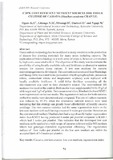Cost-efficient nutrient sources for tissue culture of cassava (manihot esculenta crantz)

View/
Date
2011-09Author
Ngugi, M.
Ombori, O.
Mwangi, M.
Gitonga, N. M.
Ogero, K.O.
Language
enMetadata
Show full item recordAbstract
Tissue culture technology has been utilized in many countries in the production
of disease-free planting materials for many crops including cassava. The
application of this technology to a wide array of crops is, however, constrained
by high costs associated with it. The objective of this study was to evaluate the
possibility of using locally available salts and fertilizers as alternative nutrient
sources for cassava tissue culture. A low cost medium for cassava
micropropagation was developed. The conventional sources offour Murashige
and Skoog (MS) macronutrients (potassium dihydrogen phosphate, potassium
nitrate, ammonium nitrate and magnesium sulphate) were replaced with
locally available fertilizers. A solid foliar fertilizer containing all the
micronutrients was used as their alternative source. The conventional MS
medium was used as the control. Both media were supplemented with 30 g/l of
table sugar and 3 g/l of gelrite. Two cassava varieties, Muchericheri and KMEI
were regenerated on the two media. The regeneration indices for both varieties
on the two media were determined and compared. The cost of culture nutrients
was reduced by 95.5% when the alternative nutrient sources were used
indicating that this strategy can greatly boost affordability of healthy cassava
seedlings. The two cassava varieties had the same regeneration index on the
low cost medium with each having a mean of 4 nodes per plantlet. However, on
the conventional medium Muchericheri had a significantly higher regeneration
index than KMEI having produced 6 nodes per plantlet compared to KME 1
which had 5 nodes per plantlet. This indicates that the developed low cost
medium can be applied to a wide scope of cassava cultivars unlike MS medium
which had genotype-dependent regeneration efficiency. The regeneration
indices of four nodes per plantlet on the low cost medium are within the
accepted limit of3-7 nodes per plantlet.
Citation
Optimimization of Agricultural Value Chains for sustainable DevelopmentSponsorhip
National Council of Science and Technology, The Kenya Seed CompanyPublisher
Faculty of Agriculture, University of Nairobi
Description
aGRO 2011 Biennial Conference presentation
